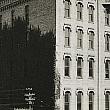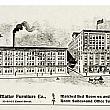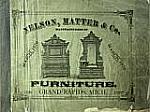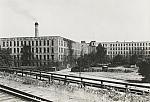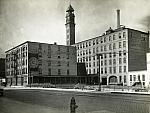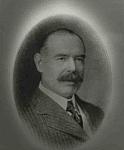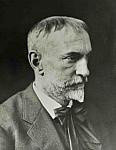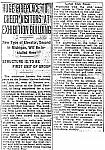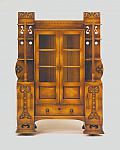Nelson, Matter and Co. - Baxter, 1891
In the early part of 1854, E. W. Winchester came to Grand Rapids from Keene, New Hampshire, where he had learned his trade as cabinetmaker and wood worker, hoping to find a good field for his skill in this then comparatively new town.
He entered into partnership with William Haldane for the manufacture of furniture. After a year this firm was dissolved, and in 1855 Mr. Winchester formed a partnership with his brother, S. A. Winchester, under the firm name of Winchester Brothers. They built a factory, a plain two-and-a-half-story frame structure, with shingled roof, which would appear insignificant now, but was then considered very large, at the corner of Lyon and Lock streets on the site of the present storage house, finishing and shipping rooms of Nelson, Matter & Company. During the panic of 1857 the Winchester Brothers made overtures to C. C. Comstock to take their plant off their hands, which change was made September 15, 1857, and the business was carried on by him until October 8, 1863.
During this time Mr. Comstock had established a branch house in Peoria, Ill., and opened a fair wholesale trade in Chicago and Milwaukee markets; also had made a complete revolution in the manner of introducing and selling furniture and cabinet wares to the trade. Prior to 1862, the manufacturer peddled his wares by chartering one or more cars, loading up his goods and starting out or sending an agent with them on the road.
Stopping at stations where business was expected or where he was desirous of opening trade, the car would be side-tracked, local dealers shown the articles for sale, and their orders filled as soon as convenient. But as the country became more densely settled, and the variety of styles increased, there came a demand for a cheaper way of introducing the goods. They could not be packed in a trunk and carried about in search of patron age; yet the styles of wares and their looks must be shown. This made it necessary for the salesman to be a fair artist, and illustrate his description by pencil sketches. In the spring of 1862 Elias Matter conceived the idea that if the pencil would show what the articles were, a picture from the camera would do it easier and better.
Mr. Comstock followed his suggestion, and now nearly every large factory has its photograph gallery as part of the needed machinery of the establishment.
In 1863 Mr. Comstock disposed of a half interest in the business to James M. and Ezra T. Nelson, and on October 8, the firm name was changed to Comstock, Nelson & Co. In August, 1865, Manly G. Colson, foreman in the factory, and J. A. Pugh, foreman of the finishing department each purchased an eighth interest from Comstock, who disposed of the remaining quarter to his son, Tileston A. Comstock, and the name was again changed to Nelson, Comstock & Co. April 16, 1870, the Comstock interest was purchased by Elias Matter, and the firm became Nelson. Matter & Company; composed of James M. Nelson, Ezra T. Nelson, Elias Matter, Manly G. Colson and James A. Pugh. September 5, 1870, Mr. Pugh died, but his estate carried on his interest until June 7, 1872, when it was purchased by the firm.
Mr. Colson died October 16, 1871, and May 9, 1872, his interest was purchased by Stephen S. Gay.
The next change in partners was June 10, 1878, when James G. MacBride and Jay D. Utley were admitted members, each buying one-third of Ezra T. Nelson's share. March 1, 1880, Ezra T. Nelson, James G. MacBride and Jay D. Utley purchased Mr. Gay's interest and he retired from the firm. James M. Nelson, the senior member, died January 18, 1883, but his interest in the firm was retained by his heirs until March 8, 1887, at which time, having withstood the vicissitudes of fickle fortune for thirty-two years, during which its progress, though slow and uphill work at first, had resulted in a large and substantial business, the institution became incorporated with a capital stock of $250,000, held by members of the old company and those who for years had been their faithful and trusted employees and who, either in the factory as skilled workmen or in the office, had done their part toward placing the firm in its strong position. The officers of the new corporation were Ezra T. Nelson, President; Elias Matter, Vice President; James G. Mac Bride, Secretary; Jay D. Utley, Treasurer.
In 1868 the company erected a building on Canal street for retail show rooms and offices, three stories and basement, 54 feet front on Canal and 8o feet deep. In 1873 the factory on the corner of Lyon, west of Lock street, was added, together with boiler, engine house and dry kilns in the rear; the former supplied with two seven-foot marine boilers and an engine of 150 horse power.
November 27, 1887, the warehouse, salesroom, office and finishing rooms on Lyon Street were destroyed by fire, and it became a necessity to replace them with another edifice. The company at once erected a structure, which they occupied in the fall of 1888, then the largest building of the kind in the State outside of Detroit. Facing on Lyon Street with 68 feet frontage, it extends on Lock to Huron street, 160 feet in length. It is seven stories high, besides basement 8 1/2 feet deep and a photograph gallery on the roof, and is built of brick and sand stone, with terra cotta ornaments and galvanized iron cornices. The floors throughout are solid, of 2 by 6 inch pine, laid edge wise and covered with inch flooring of maple, making practically a fireproof barrier between each two stories. These floors are supported by iron columns in the basement, and by oak columns above on the inside. The ceilings are thirteen feet high in the first, eleven in the next five, and sixteen sloping to thirteen and one-half feet in the top story. The upper stories are reached by two stairways, one at either end of the building, and an elevator on the west side, each enclosed with brick walls, and all openings in them provided with automatic iron doors for protection in case of fire. The photograph gallery on the roof is also reached by the elevator.
The annual output of this establishment is about $750,000, distributed all over the United States, with a fair trade in foreign countries. The product includes, besides the regular lines of furniture, specialties in chamber suits, sideboards, book-cases, chiffoniers and fine tables. They have ten traveling representatives. The manufacture keeps 450 to 500 employees, skilled workmen and others, constantly busy, and calls for a monthly pay roll of $18,000, or more.
Branch offices and warerooms are situated at 22 East 18th Street, New York City, and at 267-269 Wabash Avenue, Chicago.
EZRA T. NELSON, President of the Nelson, Matter & Company furniture corporation, was born in Milford, Massachusetts, May 9, 1824. He came of good old New England stock; his mother's maiden name being Mary Parkhurst of Milford, and his father Capt. Ezra Nelson, who won honor and prominence for himself in the war of 1812. Of his father, the town history says: "He was Captain of the once famous Milford Artillery Company, in his time honored with various official trusts by his fellow-men, and universally respected as a worthy man." Mr. Nelson's early life was spent in his native State: first on the homestead and at the village school, then at the academies of Framingham and Cambridgeport, and later as clerk in the wholesale dry goods establishment of S. F. Morse & Co., of Boston, where he remained two years.
furniture corporation, was born in Milford, Massachusetts, May 9, 1824. He came of good old New England stock; his mother's maiden name being Mary Parkhurst of Milford, and his father Capt. Ezra Nelson, who won honor and prominence for himself in the war of 1812. Of his father, the town history says: "He was Captain of the once famous Milford Artillery Company, in his time honored with various official trusts by his fellow-men, and universally respected as a worthy man." Mr. Nelson's early life was spent in his native State: first on the homestead and at the village school, then at the academies of Framingham and Cambridgeport, and later as clerk in the wholesale dry goods establishment of S. F. Morse & Co., of Boston, where he remained two years.
These years of his boyhood included a visit of some months to his brothers at Grand Rapids, Michigan, which stimulated an already strong desire to see more of pioneer life for himself, and in 1842 he turned his face westward. After a trial during the following two years of Chicago, St. Louis, Cincinnati and Columbus, he decided upon Grand Rapids as the place in which to cast his fortune. The town had scarce reached its twelfth year from settlement when, in 1844, Mr. Nelson entered business life here as clerk in the store of Henry R. Williams. After two years in this position he resigned it to join a party composed of J. Mortimer Smith, Edmund B. Bostwick and Damon Hatch, in search of adventure and copper in the Lake Superior region. He has pleasant memories of the journey from Detroit by steamer to Sault Ste. Marie, thence by schooner to Copper Harbor, of the exploration of the shores and streams in small boats, and the return, after four months, on the first steamer that ever plowed the waters of Lake Superior, though the expedition resulted only in the location of a few mines which were never developed. Returning to Grand Rapids, Mr. Nelson entered mercantile life, in which, in various branches, he remained until, in 1863, he embarked in the business into which he was to put his best energies, and the building up of which was to he his prominent life work.
The furniture establishment of Nelson, Matter & Co., is one of the three great ones in this place manufacturing exclusively fine furniture, and of the many which make Grand Rapids the greatest furniture center in the world. Their annual sales have increased, since Mr. Nelson entered the company, from $20,000 to more than three quarters of a million dollars annually, and their goods are shipped to all countries. Of the firm, Mr. Nelson is President, senior member and principal stockholder. In politics he is a stanch Republican. In his earlier years offices of trust were frequently tendered him, some of which he faithfully filled, but more often refused, though always alive to the interests of the city and proud of its high place and reputation among the cities of the West. Mr. Nelson married, October 9, 1848, Augusta M., daughter of Charles Valentine of Cambridgeport, Massachusetts. They have three daughters. As a man of sterling qualities of character, firm principle, recognized business ability and public spirit. Mr. Nelson stands high in the respect and estimation of his fellow-citizens.
 ELIAS MATTER was born in Dauphin County, Pennsylvania, Oct. 6, 1833. His parents were natives of that county. When he was eight years old his father died, and he remained with his mother on the farm during the following three years. At eleven years of age he engaged to work on a farm for his board and clothing and three months' schooling in the winter.
ELIAS MATTER was born in Dauphin County, Pennsylvania, Oct. 6, 1833. His parents were natives of that county. When he was eight years old his father died, and he remained with his mother on the farm during the following three years. At eleven years of age he engaged to work on a farm for his board and clothing and three months' schooling in the winter.
From 1850 to 1853 he served as an apprentice, learning the trade of chair and cabinetmaker, in Uniontown, Dauphin County, Pennsylvania, and was next employed for two years as clerk in a general assortment store in the same town. In February, 1855, Mr. Matter went to Rochester, New York, where he worked in a chair factory until the following September. He then came to Grand Rapids; was clerk in a boot and shoe store until the spring of 1857; next attended school three months, and taught a district school during the following two winters. In 1859 he entered the employ of C. C. Comstock, worked in the cabinet shop at piece - work some six months, and was then given the position of foreman. In the fall of 1862 he left there and entered a co-partnership with Julius Berkey, in the manufacture of furniture for the wholesale trade exclusively. In 1863 they sold an interest to William A. Berkey; in 1866 George W. Gay also came into the firm, and together they continued the business until February 1870, when Mr. Matter sold out to his partners. In April following he purchased the interest of Tileston A. Comstock in the furniture firm of Nelson, Comstock & Company, which then became Nelson, Matter & Company, now standing in the front rank of the heavy manufacturing houses of Grand Rapids.
Mr. Matter married, August 17, 1858, Anna, eldest daughter of Adam.jpg) Toot, a farmer of Irving, Barry County, Michigan. Nine children have been born to them, of whom three sons and two daughters are living. The family attends Park Congregational Church, of which Mrs. Matter is a member. Politically Mr. Matter is an adherent of the Democratic Party. He is a member of De Molai Commandery, Knights Templar; also of the Independent Order of Odd Fellows. Mr. Matter is a representative of the class who win success in business by steady and persistent effort and honorable dealing; has acquired a fair competence, and lives in a handsome residence at 112 Fountain Street.
Toot, a farmer of Irving, Barry County, Michigan. Nine children have been born to them, of whom three sons and two daughters are living. The family attends Park Congregational Church, of which Mrs. Matter is a member. Politically Mr. Matter is an adherent of the Democratic Party. He is a member of De Molai Commandery, Knights Templar; also of the Independent Order of Odd Fellows. Mr. Matter is a representative of the class who win success in business by steady and persistent effort and honorable dealing; has acquired a fair competence, and lives in a handsome residence at 112 Fountain Street.
Source: History of the City of Grand Rapids by Albert Baxter. 1891.

 facebook
facebook